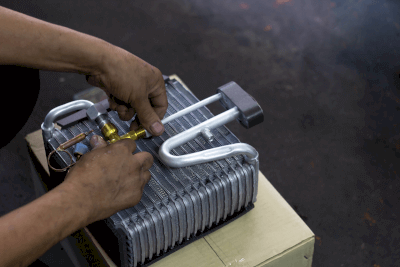What Is an Evaporator?

An evaporator is a device that evaporates a liquid or solid into a gas by reducing the pressure. When the heat of vaporization at this time is used, it is called a heat exchanger and is used in air conditioners and refrigerators. They are also used in distillation equipment to evaporate, collect, and remove solvents, as well as in vacuum evaporation equipment used to form thin films.
When used as heat exchangers, the media to be cooled are gases such as air and steam, and liquids such as water, brine, milk, and oil. The side to be cooled by heat of vaporization through decompression and evaporation is refrigerant, water, solvent liquid, etc. Heat is exchanged between the media on both sides.
Uses of Evaporators
Since evaporators are part of a system such as an air conditioning unit, they are used in combination with other equipment rather than alone. In air conditioners, evaporators are used to blow cold air into the interior of homes, automobiles, commercial air conditioners, etc.
In the field of refrigeration and freezing, it is used to cool the interior of electric refrigerators, refrigerated freezer showcases, vending machines, refrigerator cars, and low-temperature warehouses. Industrial applications include chilling units and turbo chillers for producing chilled water, oil coolers for machine tools, and absorption chillers/heaters.
In the field of physical and chemical equipment, there are distillation units that are used to remove solvents. The inside of the equipment is depressurized by a vacuum pump to evaporate the solvent, and the gas is cooled and recovered. In the semiconductor field, evaporators are also used in vacuum evaporation equipment to form thin films on the surface of substrates by heating deposition materials such as metals and metal oxides in a vacuum and causing them to melt, evaporate, or sublimate.
Principle of Evaporators
When the pressure of a liquid or solid is reduced, the saturated vapor content decreases, and the liquid evaporates to become a gas. Evaporators are devices that actively utilize this effect to evaporate. In the case of solids, they evaporate and sublimate. In the field of refrigeration and air conditioning, fluorinated compounds, hydrocarbons, water, carbon dioxide, and ammonia are used as refrigerants.
When a liquid is evaporated in depressurized evaporators, the pressure rises as it is and the evaporation stops. For continuous evaporation, the evaporators must be connected to a device that lowers the pressure and circulates the liquid. An example of this device is a refrigeration-air conditioning cycle.
As an example, let us discuss a separate air conditioner for home use. The evaporators are the heat exchangers inside the indoor unit mounted on the wall of the room. The inside of the evaporators is depressurized, and the refrigerant evaporates to remove the heat of vaporization. The airflow from the blower is then cooled by the evaporators and blown into the room as cold air. The outdoor unit includes a compressor, condenser, blower, etc., and is connected to the indoor unit by piping to form a refrigeration-air conditioning cycle. The compressor sucks in the evaporated gas refrigerant from the evaporators and maintains the evaporators at low pressure. When the compressed refrigerant is cooled with outdoor air or water, it becomes a liquid. This heat exchanger is the condenser. The liquefied refrigerant circulates to the evaporators to continue the evaporative action. At the inlet of the evaporators, a throttling device such as an expansion valve or narrow tube is installed to serve as a boundary between the low-pressure and high-pressure sides.